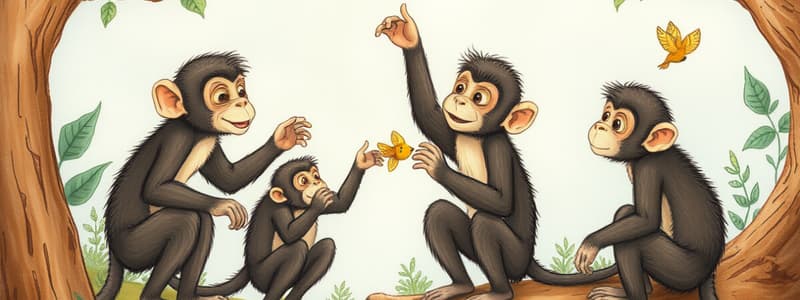Podcast
Questions and Answers
What type of social structure do monkeys live in?
What type of social structure do monkeys live in?
- Troops (correct)
- Families
- Colonies
- Herds
Which type of food is least likely to be eaten by monkeys?
Which type of food is least likely to be eaten by monkeys?
- Fruits
- Small animals
- Insects
- Fish (correct)
What is one major threat to monkeys in their natural habitat?
What is one major threat to monkeys in their natural habitat?
- Deforestation (correct)
- Predation by large animals
- Increased availability of food
- Climate change
How do monkeys typically obtain their food?
How do monkeys typically obtain their food?
What characteristic is commonly associated with monkeys?
What characteristic is commonly associated with monkeys?
Which of the following is most likely necessary for monkeys to thrive in their environment?
Which of the following is most likely necessary for monkeys to thrive in their environment?
What is a commonly observed social behavior among monkeys?
What is a commonly observed social behavior among monkeys?
Which factor is least likely to affect the population dynamics of monkeys in the wild?
Which factor is least likely to affect the population dynamics of monkeys in the wild?
Which adaptation is most critical for monkeys living in arboreal habitats?
Which adaptation is most critical for monkeys living in arboreal habitats?
What role does grooming play in monkey societies?
What role does grooming play in monkey societies?
Study Notes
Fun Facts About Monkeys
- Monkeys are characterized by their playful behavior and high intelligence.
- They primarily inhabit forests, favoring trees for living and climbing.
Dietary Habits
- Monkeys have a diverse diet that includes fruits, leaves, insects, and occasionally small animals.
- They use their hands skillfully to gather food and eat.
Social Structure
- Monkeys are social creatures that live in groups known as troops.
- Troops engage in collective activities such as playing, foraging for food, and providing protection for one another.
Conservation Concerns
- Many monkey species are endangered due to habitat loss from deforestation.
- The destruction of their natural habitats hampers their access to food and shelter.
- Efforts are needed to protect both monkeys and their habitats from further environmental threats.
Monkey Characteristics
- Monkeys are known for their playful and intelligent nature.
- They have a strong preference for living in trees, particularly in forested environments.
Habitat and Movement
- Monkeys exhibit agility, swinging from branch to branch and climbing quickly.
- They primarily inhabit tropical and subtropical forests but can be found in various ecosystems.
Diet and Feeding Habits
- Monkeys have diverse diets that include fruits, leaves, insects, and even small animals.
- They utilize their hands for grasping food, demonstrating dexterity.
Social Structure
- Monkeys are inherently social animals, forming groups known as troops.
- Troops engage in cooperative activities like playing, foraging for food, and mutual protection.
Conservation Concerns
- Many monkey species face threats due to habitat loss from deforestation.
- The destruction of their natural environment poses significant challenges for finding food and shelter.
- Conservation efforts are vital to protect monkeys and their habitats from further decline.
Studying That Suits You
Use AI to generate personalized quizzes and flashcards to suit your learning preferences.





